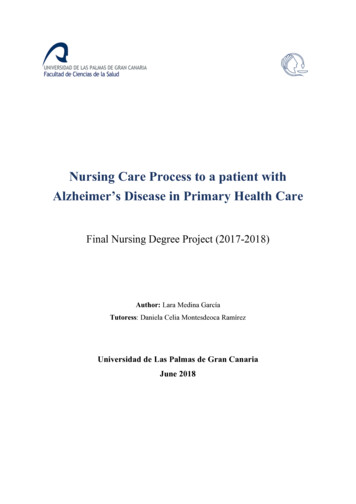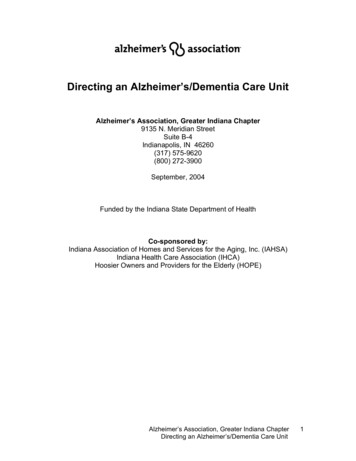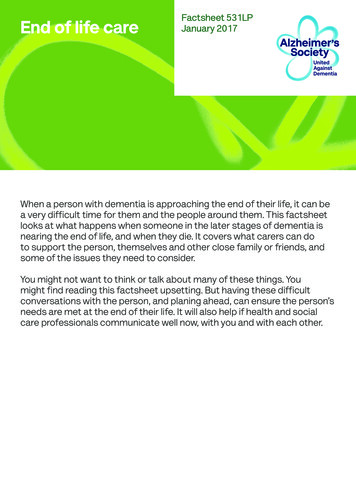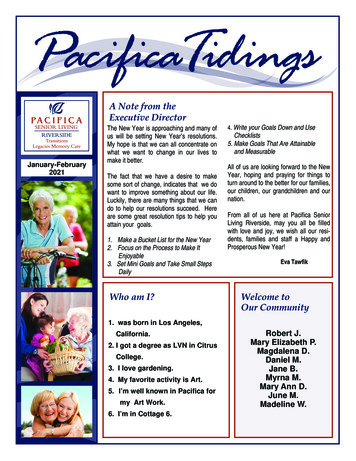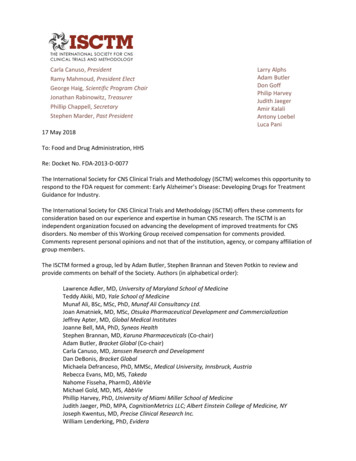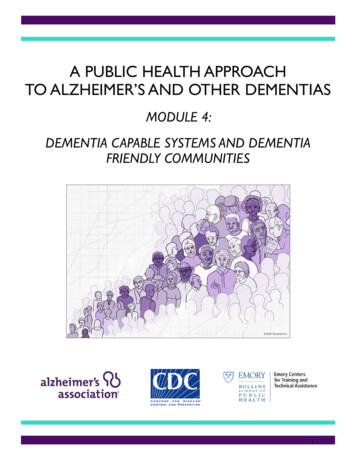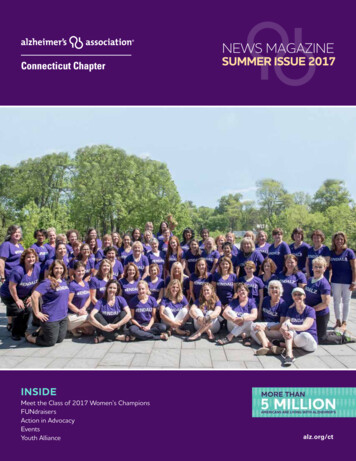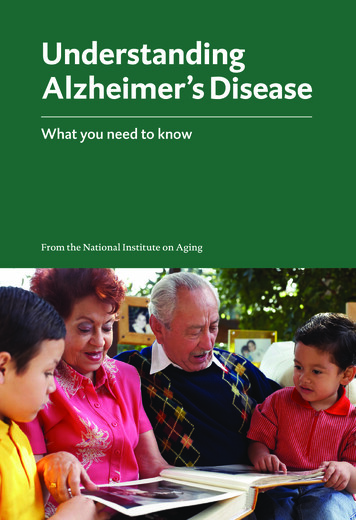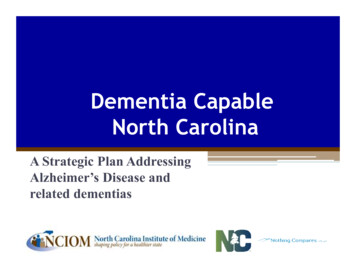
Transcription
Dementia CapableNorth CarolinaA Strategic Plan AddressingAlzheimer’s Disease andrelated dementias
State Plan on Alzheimer’s and RelatedDementias A strategic state plan for Alzheimer’s disease asrequired by GS 143B-181.1 of the NC Division ofAging and Adult Services (SB 744). State plan has been partnership of NCIOM andDAAS with The Duke Endowment, Winston SalemFoundation, AARP NC, LeadingAge NC,Alzheimer’s NC, and the NC Alzheimer’sAssociation.2
Task Force on Alzheimer’s Disease andRelated Dementia Co-Chairs: Goldie Byrd, NC A&T University; Lisa Gwyther, Duke Family Support Program; and Doug Dickerson, AARP NC 47 Task Force and Steering Committee Members Physicians, researchers, gerontologists, serviceproviders, caregivers, staff of executive agencies,and legislators. Presentations from content experts, caregivers, andpersons with dementia3
The Stigma and the Reality4
The Face of Alzheimer’s Disease &related Dementias today Sixth-leading cause of death 5.2 million Americans have Alzheimer’s disease Currently, NC has over 160,000 older adults withAlzheimer's disease or other types of dementia. In the US every 67 seconds someone developsAlzheimer’s By 2030, the total number is projected to rise to over300,000 The only top 10 cause of death that cannot be cured,prevented, or slowed
North Carolina is Aging The number of adults 65 and older will increasedramatically over the next 15 years. North Carolina ranks 9th nationally, both in totalpopulation and in the number of people 65 andolder. In 2025, one in five North Carolinians will be 65and older. Our 65 and older population will almost double inthe next 20 years from 1.5 to 2.5 million.
Caregiver Support RatioAARP Public Policy Institute
16 Focus areas requiredby Senate Bill 744 Awareness and EducationEarly Detection and DiagnosisCare CoordinationQuality of CareHealth Care System CapacityTraining for Health Care ProfessionalsAccess to TreatmentHome and Community Based ServicesLong-Term Care, Caregiver AssistanceResearch, Brain Health and Data CollectionPublic safety and safety-related needs of those w/ ADRDLegal protections for those with ADRD & CaregiversState policies to assist those with ADRD & Families
Dementia Friendly AmericaFraming the Plan Raising awareness about dementia and transforming attitudes Education, Awareness, Early Detection and Diagnosis Having supportive options that foster quality of life Quality of Care, Care Coordination, Health Care System Capacity Supporting caregivers and families touched by the disease Access to Treatment, HCBS, Long-Term Care, Caregiver Assistance Promoting meaningful participation in community life Public Safety and Safety-Related, Legal Protections Reaching those who are underserved Rural Communities, IDD population, African-American elders, Data
Raising awareness about dementiaand transforming attitudes Reducing stigma Increasing family education Promoting brain health initiatives Early screening diagnosis Promote family planning & preparation Community engagement withgrassroots organizations11
Raising awareness about dementiaand transforming attitudes 3.1 Increase awareness and promoteeducation about available resources throughincorporating Alzheimer’s disease and relateddementia-specific information in currenthealth promotion and education programs.12
Raising awareness about dementiaand transforming attitudes 3.2 Enhance training for health care providerson the benefits and best practices for detection,diagnosis, and the services referrals ofAlzheimer’s disease and related dementias. 3.3 Create a collective impact partnership todevelop and establish dementia-capable pilotcommunities.13
Raising awareness about dementiaand transforming attitudes 3.4 Establish a statewide coordinated leadershipto oversee the state plan on Alzheimer’s diseaseand related dementias.14
Having Supportive Options That FosterQuality of Life 75% of people with Alzheimer’s are admitted toa nursing home by age 80. Medicaid costs are 19 times higher for olderadults with dementia. Long-term care is provided in the home, in thecommunity and in long-term care facilities. The median annual cost for nursing home carewas in NC 77,471 in 2013. Access to care is often difficult to navigate.15
Having Supportive Options That FosterQuality of Life 4.1 Promote appropriate care settings for peoplewith Alzheimer’s disease and related dementia,including home and community-based settings,institutional settings, and hospice and palliativecare. 4.2 Examine methods of reimbursement andincentives for Alzheimer’s disease and relateddementia care through new models of care,including care management services, and palliativecare.16
Having Supportive Options That FosterQuality of Life 4.3 Assess health system capacity for people withAlzheimer’s disease and related dementias. 4.4 Improve telehealth services for people withAlzheimer’s disease and related dementias. 4.5 Increase access to medical and communityservices for people with Alzheimer’s disease andrelated dementia by improving transportationservices through an inter-departmental workinggroup.17
Having Supportive Options That FosterQuality of Life 4.6 Apply principles of person-centered care to thecare processes and protocols at health careproviders and facilities for people with Alzheimer’sdisease and related dementia. 4.7 Improve quality of care and care coordination forpeople with dementia through improved ratingssystems and dementia-specific indicators.18
Having Supportive Options That FosterQuality of Life 4.8 Improve care coordination for people withAlzheimer’s disease and related dementia throughnew models of care. 4.9 Expand the Dementia Friendly Hospital initiative. 4.10 Promote Alzheimer’s disease and relateddementia-specific training for health professionalsand community workforce.19
Having Supportive Options That FosterQuality of Life 4.11 Incentivize entry into geriatric and gerontologyspecialization and additional training in dementiacare. 4.12 Increase compensation based on Alzheimer’sdisease and related dementia-specific training andcertification.20
Supporting Caregivers and Families Caregiver ratios will change from 8/1 in 2010 to3.9/1 in 2030. Community-based supports, including respite,delay institutionalization. Extensive waiting lists for HCBS limit caregiveroptions for care. Employed caregivers face logistical and financialdifficulties when providing care. Caregivers are at risk for stress, depression anddeclining personal health.21
Supporting Caregivers and Families 5.1 Promote integration and accessibility ofdementia-specific resources through acomprehensive caregiver toolkit and a virtualresource center. 5.2 Ensure adequate funding for family caregiversupport services including dementia-specific respitethrough NC Project C.A.R.E. 5.3 Continue No Wrong Door Initiative through acollaboration with NC 2-1-1.22
Supporting Caregivers and Families 5.4 Enhance employer policies to support familycaregivers. 5.5 Examine outcomes and impact of home andcommunity-based services programs. (CAP) 5.6 Expand the Medicaid Home andCommunity-Based Services Waiver Program. 5.7 Implement best practices for the integrationand coordination of home and community-basedservices.23
Promoting Meaningful Participationin Community Life Individuals with dementia are at risk for fraud,abuse, financial exploitation, self neglect and theneed for guardianship. Families need awareness of advanceddirectives, including Powers of Attorney, longterm care planning and financing. Wandering, falls and driving are safety risks forpersons with Alzheimer’s and related dementias.24
Promoting Meaningful Participationin Community Life 6.1 Increase awareness of legal protections andvulnerabilities of people with Alzheimer’sdisease and related dementia. 6.2 Incorporate legal protection issues specificto people with Alzheimer’s and relateddementias into health, legal, and financialprofessional training.25
Promoting Meaningful Participationin Community Life 6.3 Examine state statutes to determineadequate legal safeguards and protections forpeople with Alzheimer’s disease and relateddementias. 6.4 Integrate elder fraud and abuse data toimprove services for people with Alzheimer’sdisease and related dementia.26
Promoting Meaningful Participationin Community Life 6.5 Improve home safety resources andworkforce capacity. 6.6 Enhance public safety and law enforcementoutreach around Alzheimer’s disease andrelated dementia.27
Reaching Those Who AreUnderserved The prevalence of dementia is significantly higherfor persons with African Americans, Latinos, andthose with Intellectual and DevelopmentalDisabilities (IDD) Deaths related to dementia are highlyunderreported. Participation in clinical trials is key to successfulresearch. Prevalence data is currently estimated28
Reaching Those WhoAre Underserved 7.1 Support Alzheimer’s disease and relateddementia research through the establishment ofa statewide collaborative registry. 7.2 Continue periodic inclusion of cognitiveimpairment and caregiver modules of theBehavioral Risk Factor Surveillance System(BRFSS)29
Reaching Those WhoAre Underserved 7.3 Improve prevalence data through accuratedeath certificate completion. 7.4 Improve data on Alzheimer’s disease andrelated dementia prevalence throughimplementing a statewide data reporting system.30
Next Steps: A Living Document for the Division ofAging and Adult Services and NC DHHS. NC Alzheimer’s Coalition Priority setting and new initiatives Dementia Friendly America Workshop onOctober 18 Wake Forest, NC31
For More InformationAdam Zolotor, MD, DrPHInterim President and CEONorth Carolina Institute of Medicine919-445-6150adam zolotor@nciom.orgMark Hensley, MAAlzheimer’s Specialist & State Project C.A.R.E. DirectorNC Division of Aging and Adult Services919-855-3417Mark.Hensley@dhhs.nc.gov32
Dementia Capable North Carolina A Strategic Plan Addressing Alzheimer’s Disease and related dementias. State Plan on Alzheimer’s and Related . dementia care through new models of care, including care management services, and palliative


